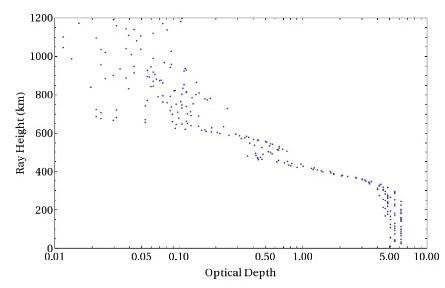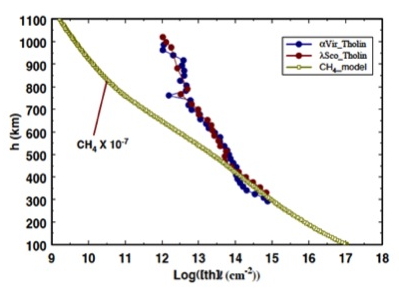2012 Annual Science Report
 NASA Jet Propulsion Laboratory - Titan
Reporting | SEP 2011 – AUG 2012
NASA Jet Propulsion Laboratory - Titan
Reporting | SEP 2011 – AUG 2012
Task 2.1.1.2 Titan Aerosol Chemistry
Project Summary
The observed vertical profiles of Titan organic aerosols have been analyzed and the possible chemistry forming these aerosols studied. The elementary reaction of the ethynyl radical with diacetylene represents an efficient pathway to produce triacetylene in Titan’s atmosphere in those regions where density profiles of photolytically-generated ethynyl radicals and diacetylene overlap. The model of Titan’s atmosphere indicates that successive reactions of the triacetylene molecule can yield even more complex polyynes. These polyynes are thought to be the basis out of which the organic aerosols are formed.
Project Progress
Co-Investigator Yuk Yung with graduate student X. Zhang and colleagues M.-C. Liang and R. I. Kaiser studied the formation of organic aerosols in the Titan atmosphere.
For the last four decades, the role of polyynes such as diacetylene and triacetylene in the chemical evolution of the atmosphere of Saturn’s moon Titan has been a subject of vigorous research. These polyacetylenes are thought to serve as an ultraviolet radiation shield for the Titan atmosphere. However, the underlying chemical processes that initiate the formation and control the growth of polyynes have been the least understood to. This may change as more high quality Cassini data become available.
Detailed vertical profiles of minor species from 100 to 1000 km and of tholins above ~300 km have recently been deduced from Cassini-UVIS observations. See Figures 1 and 2. Figure 2 demonstrates that the scale height of tholins is larger than CH4, consistent with a large source of tholins in the upper atmosphere of Titan.
In recent work, they modeled the chemistry of complex organic compounds on Titan. The insertion reactions exhibit no entrance barrier, are exothermic, and all transition states, which are involved, are below the energy of the reactant molecules. Due to these characteristics, the elementary reaction of the ethynyl radical with diacetylene represents an efficient pathway to produce triacetylene in Titan’s atmosphere in those regions where density profiles of photolytically-generated ethynyl radicals and diacetylene overlap. Their model of Titan’s atmosphere indicates that successive reactions of the triacetylene molecule can yield even more complex polyynes. Here, ethynyl radicals (CCH) or 1,4-butadiynyl radicals (HCCCC), formed via photodissociation of acetylene and diacetylene, respectively, can react with triacetylene to tetra-acetylene (C8H2) and penta-acetylene (C10H2), respectively. This offers important sinks for triacetylene and produces potential polyyne precursors for the organic aerosol layers. To match the observed profiles of three major C2-hydrocarbons (C2H2, C2H4, and C2H6), modifications to the existing kinetics and vertical transport are needed. The latter plays a crucial role. Incorporating these modifications and a parameterized aerosol formation pathway into a chemistry-diffusion model, they could explain the observed tholin profile made by the Cassini-UVIS instrument. Processes that affect the profile are (1) aerosol production, (2) aerosol coagulation, and (3) dynamical transport. This work has implications for the organic material sequestered on the surface of Titan.

Figure 1. Line-of-sight optical depth at 1850-1900 A in the atmosphere of Titan from Cassini-UVIS. The scatter at the top is due to low signal; the constant value at the lower end is due to saturation.

Figure 2. Profiles of aerosol abundance from two Titan TB occultations compared to the scaled CH4 profile.
-
PROJECT INVESTIGATORS:
-
PROJECT MEMBERS:
Ralf Kaiser
Collaborator
Mao-Chang Liang
Collaborator
Xi Zhang
Doctoral Student
-
RELATED OBJECTIVES:
Objective 2.2
Outer Solar System exploration
Objective 3.1
Sources of prebiotic materials and catalysts
